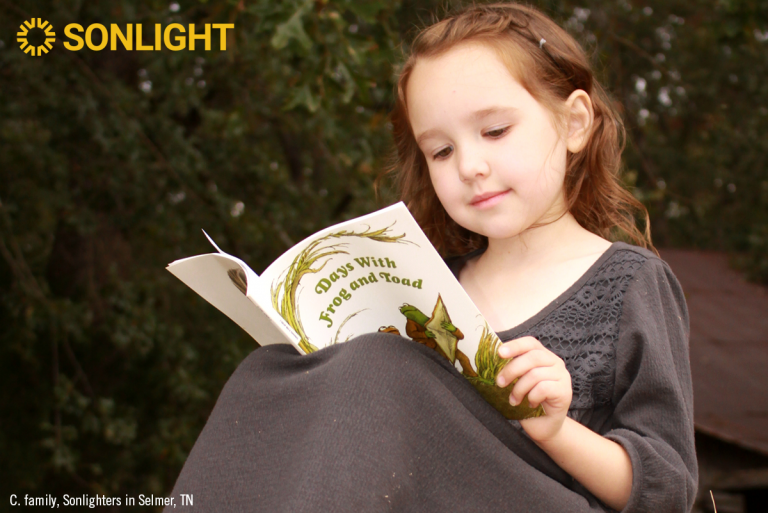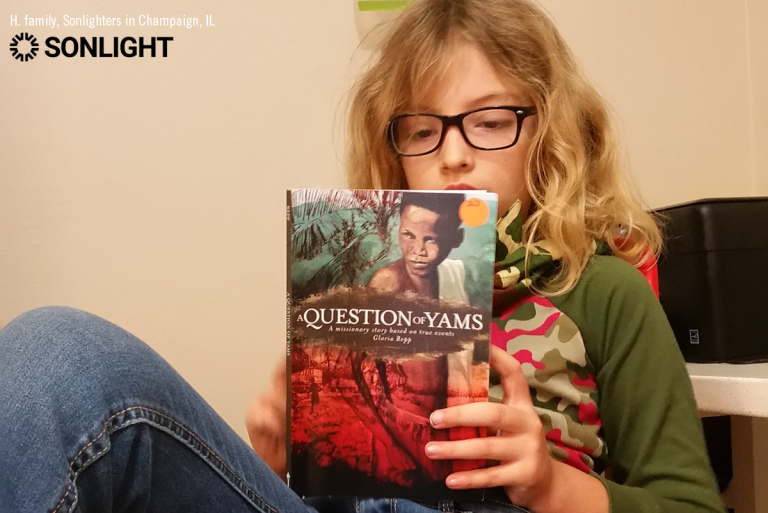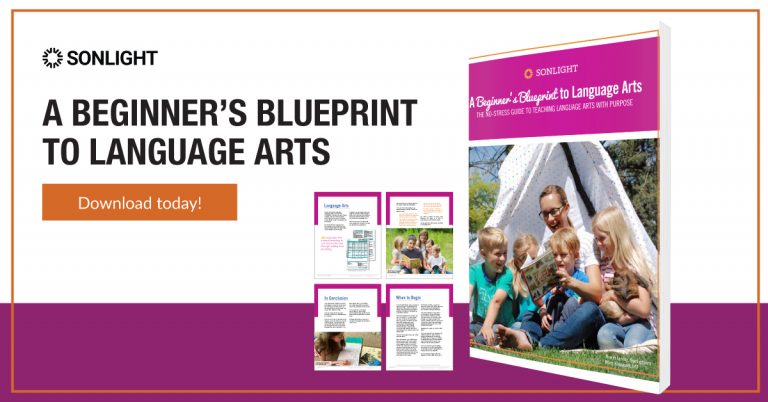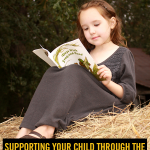
"I absolutely love that with Sonlight, your kids don't get stuck in a one-size-fits-all grade box with all the other kids. The stacks of delicious books, the discussions the books spark, the joy of learning together, and the confidence that our kids are getting a great education: it's well worth every penny. The IGs are so well-researched and easy to use that I can just open and start teaching!"
Anna C of Selmer, TN
While I don’t generally get too caught up in labeling our children, it is sometimes helpful to see the stages of your reader and explore how you can best support your child at each level. So much of homeschooling is simply facilitating a child’s natural curiosity and desire to learn and grow. So how do we support our reader at each stage of their journey? Here are a few tips.
Please note that I’m not including ages along with these reading stages, and I would discourage you from doing that as well. All children learn at a different pace, and you may find that you spend years in one of these stages and jump rather quickly over the next one.
Don’t be discouraged if your child isn’t right in line with other children their age. Remember that you are looking for steady progress, not perfection and not arbitrary age level learning targets.
1. The Emergent Reader
This stage is all about exposure. In the emergent stage, you’ll want to talk, talk, and talk some more to your child. Talk all the time.
When I was at home with my young children, I would talk all day. I would tell them everything that I was doing. I would repeat the word for everything they looked at.
This is also the stage where you’ll begin to introduce letters. Reading picture books is a great way to start this process. Alphabet books like Dr. Seuss’s ABC Book are so fun for kids in this stage. You’ll also want to keep a good nursery rhyme treasury close by. Be sure to include some indestructible board books in your child’s toy basket. We also always loved the Leap Frog refrigerator magnet set for reinforcing letter sounds.
You’ll also want to keep plenty of age-appropriate writing tools at hand because you will encourage early writing at this stage. Don’t worry! I’m not talking about story-writing! Skills like coloring, early drawings, and finger painting all count for early writing experiences. Sonlight History / Bible / Literature (HBL) T, P, and A are great choices for an emergent reader.
I don’t recommend formal instruction at this stage. Most of the learning here happens independently and organically. Parents are, for the most part, facilitators, focused on gathering the supplies needed for the child to explore. Of course, interaction is always a good thing, but I would caution against pushing early instruction too hard. Sometimes, this can cause children to tire early because they are being pushed to learn something they are not ready for. Allow the child to initiate any type of instruction.
2. The Novice Reader
The novice reader’s focus is on phonics. This is the stage where you’ll want to begin some more formal reading instruction by introducing letter sounds. You may also begin to introduce sight words at this stage. This is a fantastic time to begin having your child sound out words and watch their little eyes light up when they figure it out all by themselves.
I absolutely love the Explode the Code series for this level.
You’ll still want to talk to them often and read picture books aloud to them. At this point, it’s a great idea to begin following the words along the page with your finger.
Children in this stage will do best with predictable reader-style books such as easy Dr. Seuss or the Fun Tales set.
Novice readers will likely also be trying their hand at writing words. Don’t fret over spelling. Let them invent their spelling and encourage them to record it on paper exactly how they hear it. Encourage them to draw a picture and write a few words about their picture. Have them read the story to you and record it on the back of the paper correctly so you’ll have a record of those sweet early stories.
This stage is still heavily dependent on a parent. Lots of sweet memories are made here by reading first stories in the lap of mama or daddy. Sonlight HBL A is a great fit for a novice reader.
3. The Decoding Reader
In this stage, you’ll be headed into a new level of phonics. You’ll discuss more complex consonant patterns, syllable patterns, and of course, those pesky exceptions to the rule. The Explode the Code series will help you present these rules in a logical order.
While you’ll still be needed for formal instruction, you’ll get to hand over a touch of independence at this stage. Children begin reading independently, but you’ll still want to hear them read portions of their daily reading so that you can correct any phonetic mistakes before they become a habit.
Since I have multiple children, at this stage, I begin listening to them read a short portion of their daily reading and then assigning the rest. At the end of the reading time, I call them back briefly to talk about what they read. Sonlight HBL B and C are great options for this stage reader.
This is a great time to introduce an additional D.E.A.R. time (Drop Everything And Read). If you participate as well, this will become a much treasured time of your daily family flow. A couple of notes about this: D.E.A.R. time should be freely chosen books, but at the decoding stage, you’ll still want to assist your child in choosing a developmentally appropriate book. I never discourage easy books, but I do caution my young readers against books that are too complicated for their independent reading. A D.E.A.R. book should be something that can be read with little to no assistance.
I like to keep a home library, but the decoding stage provides a great opportunity to introduce your children to your local library with weekly or monthly visits. This habit promotes reading as a way of life.
Your decoding reader will also probably show a new interest in recording their thoughts on paper. Allow this often! This is a great time to encourage your child to explore their imagination and their new-found ability to put their thoughts on paper. If you find your child resistant to this, don’t worry! Be their scribe. Have them tell you their stories and you record them. Eventually, this will transition into independence. Just be patient, and you’ll have a blossoming reader and writer.

"[Lydia (9)] is reading her first missionary story and is captivated by the drama. At the time of this picture, we worked in a Bible translation organization and heard many stories. But this was the first biography on her reading level. The Sonlight readers have been an excellent fit as part of our language arts because we can customize the different parts for our needs and different levels depending on the subject. Our family's first Sonlight product was the readers. The variety and quality of the reading list has not disappointed us yet!"
Cynthia H. of Champaign, IL
4. The Fluent, Comprehending Reader
This is such a fun stage! Your child is discovering they can use reading to find out anything they want to know! Phonics instruction is basically finished at this point, and now you are moving into a new focus on comprehension. You’ll still be needed during instruction, but your child will likely be working independently for the most part.
In this stage, you’ll be handing over their reading assignments almost completely. Of course, if you just can’t bear it, you can do what I did, and continue to listen to them read just because you love the stories so much! However, if you can’t do that, you’re child will be just fine handling the daily reading assignments. Simply be sure that you check in and have them narrate their reading back to you. Show a genuine interest in the story and model skills of a good reader. You might say out loud…
- Hmmmm...that sounds exciting! I wonder what will happen next?
- What do you think ________________ should do?
- I think _______________ seems cold and uncaring. I wonder if he will change?
You can depend heavily on the Sonlight Language Arts Instructor's Guide to tell you everything you’ll need to cover. Simply go over each day’s assignment with your child and turn them loose. Be sure to check over it after they finish and have them correct any mistakes immediately. Remember, you don’t want mistakes to become habits.
Again, if your child struggles with their writing, continue the partnership in writing until your child feels more confident. You might also allow them to record what they want to write first to get their ideas flowing, and then have them write it down.
Continue your regular visits to the public library and be sure to continue D.E.A.R. time. Your child probably has a pretty good grasp of what they can read now, so you’ll be able to let them choose their recreational reading for the most part. Sonlight offers a great range of options for this stage of reading. HBL D through HBL J are great choices for the fluent reader. Be sure to have lots of conversations with your child about what they have read.
5. The Expert Reader
Your child has arrived! This is the stage where all the hard work pays off. Your child can now read anything. No information is unattainable as long as there is a book to explain it!
They will begin exploring all kinds of topics ranging from math and science to philosophy. At this stage, the parent can truly sit back, relax and enjoy their new role as a facilitator and a book club member. Your job is now to talk with great interest about your child’s reading adventures. You might even decide to read a book together and have weekly coffee dates to discuss it.
This is also a great time to encourage your child to dive deeper into their Bible studies. You’ll want to provide a concordance and a Bible dictionary to help your child enter into a new level of exploring and analyzing the Bible. I would highly recommend having your child read the book Women of the Word by Jen Wilkin. Even if your child is a male, this is a great resource for learning how to study the Bible.
Your child will be at the upper levels of learning now. Instead of only comprehending literature, they will be able to analyze themes, evaluate ideas, and even create new ideas and opinions based on their reading. This is an exciting time in the life of a student. Make sure your child has plenty of exposure to great books. All six of the Sonlight high school courses are appropriate for this level of reader. Take advantage of the wide range of options and consult with your child to see what is most interesting to them.
Reading is such a wonderful thing. My son has been in our homeschool for the past seven years, and for seven years, we have depended on Sonlight’s reading and language arts to guide us. This year, he took the ACT Aspire test. While I truly don’t think much of test scores, I was impressed when he brought home a score that placed him in the 98th percentile in reading. He scored a full year ahead of most of his peers in reading.
Of course, even better than any standardized test, is the fact that he loves to read and chooses reading as a hobby. So I strongly encourage you to trust Sonlight. Follow the plan and enjoy it.
If your child is lagging behind where you think they should be, trust the process and stick with it. Reading proficiency will come. Whatever stage you’re in, enjoy it! It’s here today and gone tomorrow.
Language Arts includes so many pieces. This guide helps you see the big picture—what to teach and when.








